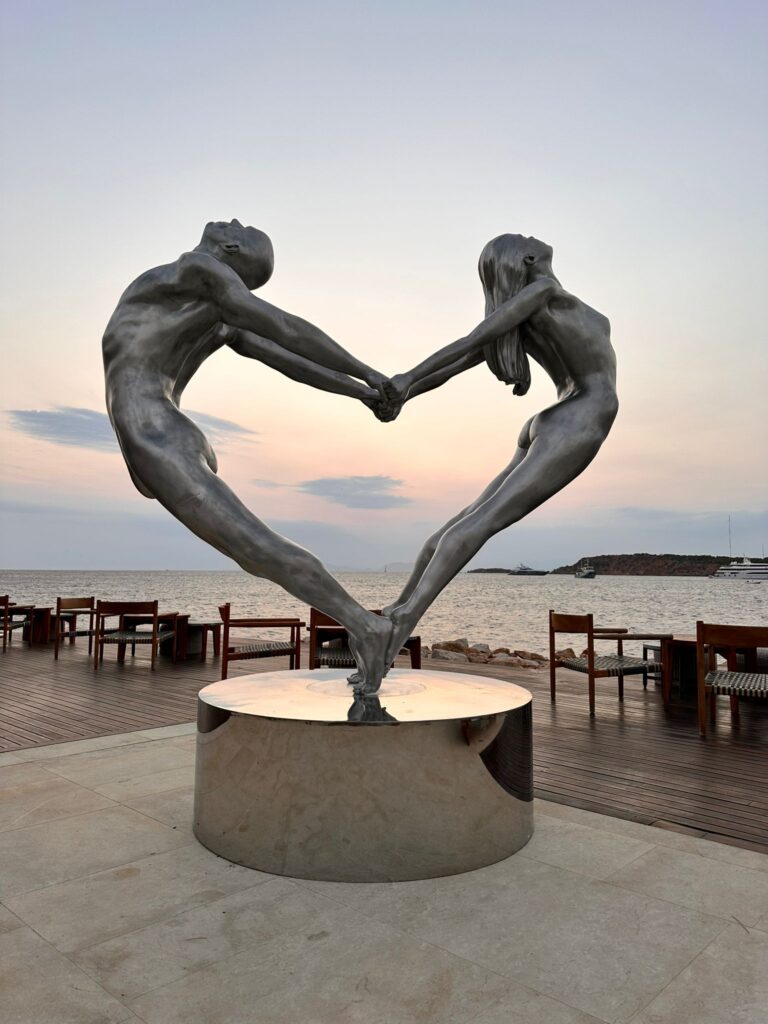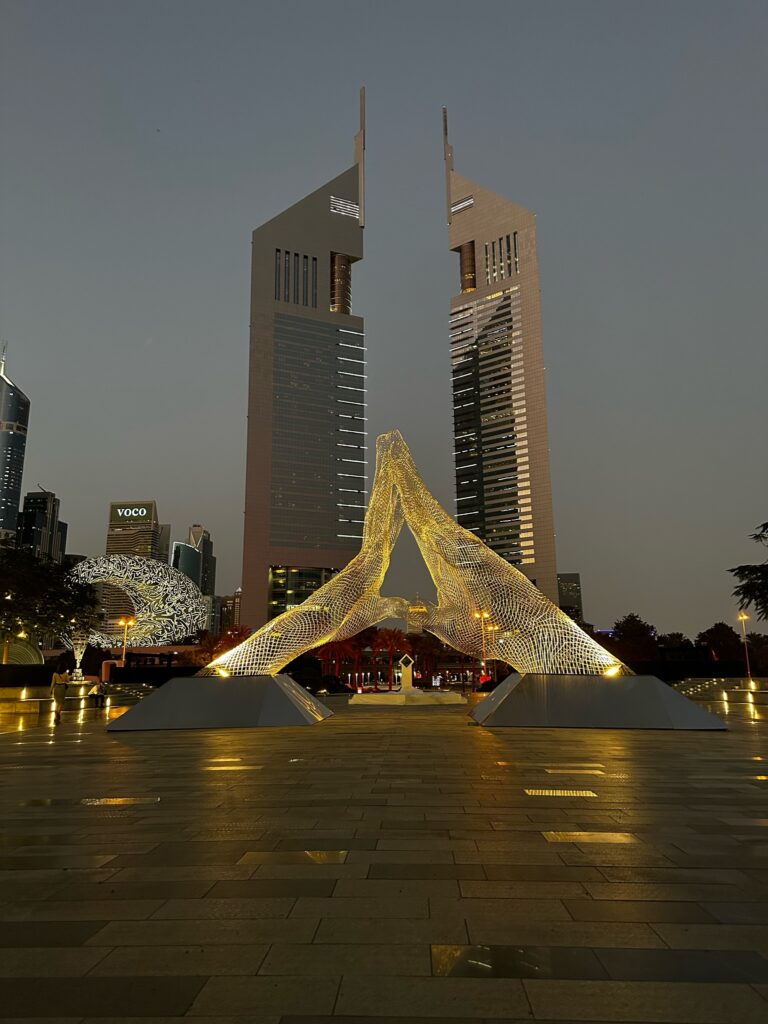
What led you to pursue a career in sculpture, and are there any specific events or experiences that shaped your decision?
I was 20 years old and attracted to different arts—acting, painting, sculpting, and actually, even singing. I wrote an album and I was in a band. I knew for sure that I wanted to be in the arts, but I couldn’t decide which one because all of them attracted me for different reasons. In fact, I presently incorporate all of them into my sculptures. I have interpreted some of my sculptures into songs like “Give and Receive” and “Finding Love,” both which have been published on Spotify. I have more in the works as well. While I was acting, I studied drama and theatre at NYU. I was a fine arts major and was offered a role as the famous painter Salvador Dalí. Funny enough, I was a surrealist painter myself and I loved Dalí. I was trying to copy him, but when I played him, I realized I wasn’t him. Dalí was unique. He was a genius. And I was just a bad copy. I realized that as an artist, I had to find my own niche and bring something new. That’s when I moved away from painting and onto sculpting. I moved away from surrealism and toward symbolism, where I started bringing meaning and text to every sculpture I made.
Can you share some of the specific influences that have shaped your creative style and approach to art?
Before I make a sculpture, I need the idea. It’s like sitting down and writing a book. What am I going to write about? I don’t just simply start writing. Is it an epic adventure? Is it a thriller or historical biography? The same goes with sculpting, especially with sculpting. You need a structure to support the sculpture itself. You need to know what you’re going to sculpt before you start. So, I always start with text. I always try to find a subject matter that I want to talk about. Usually, it’s about love, bringing people together, or the universal language of unity. There’s so much hate out there and I try to fight it with love. I’ve also worked around climate change and social matters. But it’s always about the text first. Once I write the text, I find the inspiration and get a visual or that spark, which then translates into the art.
How do you transform abstract concepts and emotions into tangible sculptures?
That’s the hard part. For years, I have had some subjects in my mind that I don’t know how to transfer into a 3D format. They’re in my mind and I try to materialize them, but I just can’t find the proper way to do it. It’s not always easy, but at times, you have that famous eureka moment where you think, that’s it, that’s what I want to do, that’s how I’m going to interpret this sculpture. But other times, it doesn’t work. Sometimes, there are concepts that will sit dormant for years and years and you just can’t find the right way to express that emotion. At times it’s immediate, but you never know when you’re going to get that inspiration. You never know when it’s going to be clear to you how to say what you want to say. With this busy schedule of mine, however, I usually get the best ideas when I’m on a plane or driving in a car—moments when I am with myself, when I am silent and not connected. I am able to step back, think, and concentrate, which is so important.

How does your Italian heritage influence your artistic style, particularly in your expressive recreations of human hands?
I did grow up in Rome and was confronted daily with great master works by Renaissance artists. This was incredibly inspiring, but I saw it as a challenge and one that was going to be difficult to surpass. In fact, I still do today. In one way, it has inspired me and, in another way, it has completely depressed me because I feel that I could never do what these great masters of the past have done. And to a great extent, I don’t think anybody has been able to repeat that. I think I’m very good at communicating emotions. I am very good at expressing them and conveying messages universally. But the mastery of these past artists is unsurpassed. As far as my Italian background though, I think that maybe it’s been more about the sensitivity toward Renaissance art and its techniques. But actually, I’ve been very American in my approach to art. I also realized from the beginning that if I wanted to keep on creating, I had to know how to promote my work. And that in itself is a very American approach.
Considering the significance of hands in your sculptures, could you elaborate on the symbolic message you intend to convey through their various positions, gestures, and interactions within your artwork?
Because all of my sculptures are made to share and spread a message, whether it be a message of unity or a message about climate change, I have to do it in a way that is intelligible. I have to do it in a way that people can universally understand. I have to find a way to share it with the world without creating barriers, but by creating bridges. Therefore, I have to use a language that most people understand because my art is not only intended for art lovers, but for the public at large. And not everybody is an avid museum goer or even likes art. But that is not the point. The point is to convey a message and I have to do it in a way that I can reach everybody, regardless of their social background, interests, or ethnicity. By using hands, I have seen that I have been able to achieve that because we can all identify with them and make them our own. That’s why I use hands, but of course, I don’t only use hands because that would be quite boring. I don’t think that you should ever box yourself into one certain thing. Yes, the hands have achieved greatness. They are absolutely, one hundred percent immediately recognizable and they have, as they say in business world, cornered the market, because nobody could execute a big figure or slim figure without thinking of Botero. But, at the same time, it kind of limits your creativity and I did not want to box myself into just making hands. It is, however, the best way to convey certain messages, especially in the public realm with my bigger installations.

In your opinion, what role does public art play in society, and why do you believe it is important to create thought-provoking work?
Not all people walking the streets are art lovers, but each one of those people can be important for social change. All it takes it one person. I try to spark emotion within people and hopefully, help them see things
in a different way. Basically, my art is just a visual expression of a message I’m trying to convey, which is usually about love, universal values, and caring for ourselves and our planet. I know that art is not always appreciated, especially by the critics. Sometimes, they see it as lighthearted work or feel that at times, your work almost has to be very complex or controversial. I don’t agree with that. That is simply not what I’m trying to do. I’m very happy that I am able to convey very complex subjects into simplified visual forms. I think it can be very difficult to do that, to make something complex into something simple. But for me, it’s very important.
In your artistic journey, have you encountered any specific challenges unique to sculpting as a medium, and how have these obstacles impacted your creative process?
Yes, mainly dealing with the force of gravity. It hinders the process often. I would love to be able to do things differently, but I am constantly held back by gravity itself. I would love my structures to be more free-flowing and even independent, like floating, to convey the message. In order to do that though, I have to use smart engineering to make it look like it’s floating, but ensure it is secure and fastened to the ground. That is very, very difficult to achieve and sometimes, I have not been able to achieve it. I have actually had to abandon some of my ideas because they were unrealizable, due to gravity. As we work with new materials, I’m able to surmount some of these obstacles and that’s why I keep studying new techniques. I can apply that more to smaller scales sculptures, but for larger outdoor art, we have to follow strict rules and regulations as stated by the city councils. There’s also climate issues to take into consideration, depending on where you are placing the artwork. This can alter the design of the work as well.
Are there any upcoming projects or themes that you are particularly excited to explore in the future?
Yes, of course. If I didn’t have this, I would be over. I think though, one of the greatest challenges I am faced with constantly is when I’ll have moments of great inspiration. There are times when inspiration is really flowing from my mind and into the material itself. It is a great energy, a surge of inspiration that usually happens in moments in my life when something has deeply affected me. It’s usually when I am very emotionally engaged. The problem is that then, you also have moments where all of that inspiration just leaves you and you’re always worried about when it’s going to come back.
